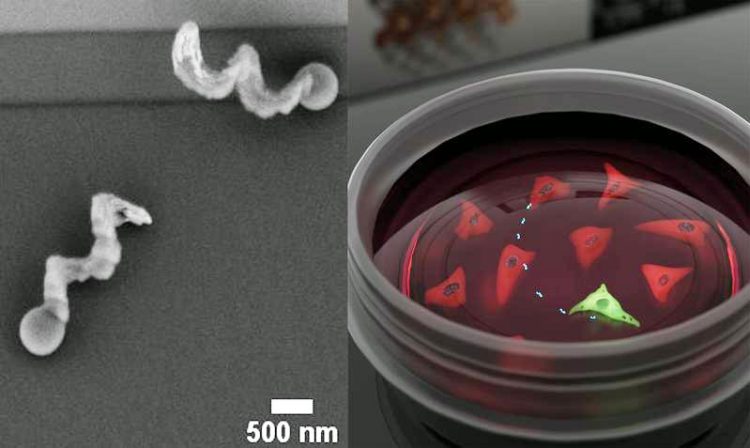Magnetic nanopropellers deliver genetic material to cells

Two micrometer long and 500 Nanometer wide iron-platinum nanopropellers (left) enable genetic modification of cells, which then start expressing green fluorescing protein (right). MPI für Intelligente Systeme
Scientists from the Micro Nano and Molecular Systems Lab and the Modern Magnetic Systems Department at the Max Planck Institute for Intelligent Systems (MPI-IS) have succeeded in developing hard-magnetic nanomagnets that could one day enable new procedures in medicine and smaller devices in minimally invasive surgeries.
Using an iron platinum alloy, the researchers fabricated drill-shaped nanopropellers that are the size of a bacterium. In collaboration with scientists from the Francis Crick Institute, a biomedical research centre in London, and the Max Planck Institute for Medical Research in Heidelberg, the researchers showed that the magnetic nanopropellers are fully biocompatible, i.e. have no adverse effects on cells, and can deliver genetic material.
“The fantastical sounding idea that magnetically steered nanopropellers could one day enable the precise targeting and delivery of genes or drugs, holds great potential in medicine. We just came one small step closer to its realization,” says Peer Fischer, who heads the Micro Nano and Molecular Systems Lab and is a pioneer in the research field of nanopropellers.
Major challenges to using magnetic nanoparticles in biomedicine are that some commonly used magnetic materials exhibit unacceptably high toxicity (nickel, cobalt), others are difficult to fabricate (zinc ferrite), exhibit low chemical stability (iron corrodes) or have very weak magnetic moments (iron oxides). Additionally, commercially popular neodymium iron boron (NdFeB) supermagnets cannot be fabricated or used at very small scales thus far. Hence, finding a perfect material for this application is very challenging.
The team from the Micro Nano and Molecular Systems Lab overcame these restrictions by fabricating a new kind of magnetic nanopropeller. The Stuttgart scientists succeeded in growing nanostructures with magnetic properties that outperform the strongest known micromagnets (NdFeB), yet are chemically stable and biocompatible. These new nanopropellers are based on the iron platinum “L10” alloy, and are very promising because they combine everything real-world applications would require for magnetic targeting.
These excellent magnetic properties of iron platinum materials were previously achieved by the Modern Magnetic Systems Department at the MPI-IS, which is led by Gisela Schütz. “We succeeded in producing FePt nanomagnets that are about 50 % stronger than the world’s best neodymium compounds,” says Schütz.
Teaming up with the Micro Nano and Molecular Systems Lab, they developed a fabrication method for FePt nanopropellers using the specialized high-vacuum nanofabrication method “Glancing Angle Deposition” (GLAD) followed by an annealing step at close to 700 degrees. As with previous projects, GLAD enabled the simultaneous fabrication of billions of nanorobots in just a few hours, making this an easily scalable process.
With the support of biologists Maximiliano Gutierrez and Claudio Bussi from the Francis Crick Institute and bioengineer Andrew Holle from the Max Planck Institute for Medical Research, the team then showed that the non-toxic propellers enable active gene delivery.
They coated the propellers with DNA coding for green fluorescent protein. The propellers transported the DNA inside lung carcinoma cells which then started emitting green light. The researchers were able to precisely steer propellers through the cell media surrounding the cells.
Due to the hard-magnetic properties, which rival those of strong NdFeB micromagnets, the propellers are the fastest ever created in the Micro Nano and Molecular Systems Lab and reach speeds of 13 propeller lengths per second.
Vincent Kadiri is the first author of the highly interdisciplinary research project “Biocompatible magnetic micro- and nanodevices: Fabrication of FePt nanopropellers and cell transfection”, which was published in Advanced Materials on 6th May 2020. He expects that iron-platinum will also be adopted in the fabrication of other micro and nanodevices.
“I am very happy that we succeeded in constructing biocompatible nanopropellers from FePt that outperform what has so far been used in the field. It will be exciting to see the new applications this will enable.” FePt shows great potential for use in micro-robotics and a diverse range of biomedical applications. Maximiliano Gutierrez, who studies the dangerous tuberculosis pathogen, adds: “Biocompatible nanopropellers could represent a very smart strategy to deliver antibiotics and tackle the problem of antimicrobial resistance.”
Vincent Mauricio Kadiri
Micro, Nano, and Molecular Systems
kadiri@is.mpg.de
https://onlinelibrary.wiley.com/doi/full/10.1002/adma.202001114
https://is.mpg.de/news/magnetic-nanopropellers-deliver-genetic-material-to-cells
Media Contact
All latest news from the category: Interdisciplinary Research
News and developments from the field of interdisciplinary research.
Among other topics, you can find stimulating reports and articles related to microsystems, emotions research, futures research and stratospheric research.
Newest articles

How marine worms regenerate lost body parts
The return of cells to a stem cell-like state as the key to regeneration. Many living organisms are able to regenerate damaged or lost tissue, but why some are particularly…

Nano-scale molecular detective
New on-chip device uses exotic light rays in 2D material to detect molecules. Researchers have developed a highly sensitive detector for identifying molecules via their infrared vibrational “fingerprint”. Published in Nature…

Novel CAR T-cell therapy
… demonstrates efficacy and safety in preclinical models of HER2-positive solid tumors. The p95HER2 protein is found expressed in one third of HER2+ tumors, which represent 4% of all tumors….



